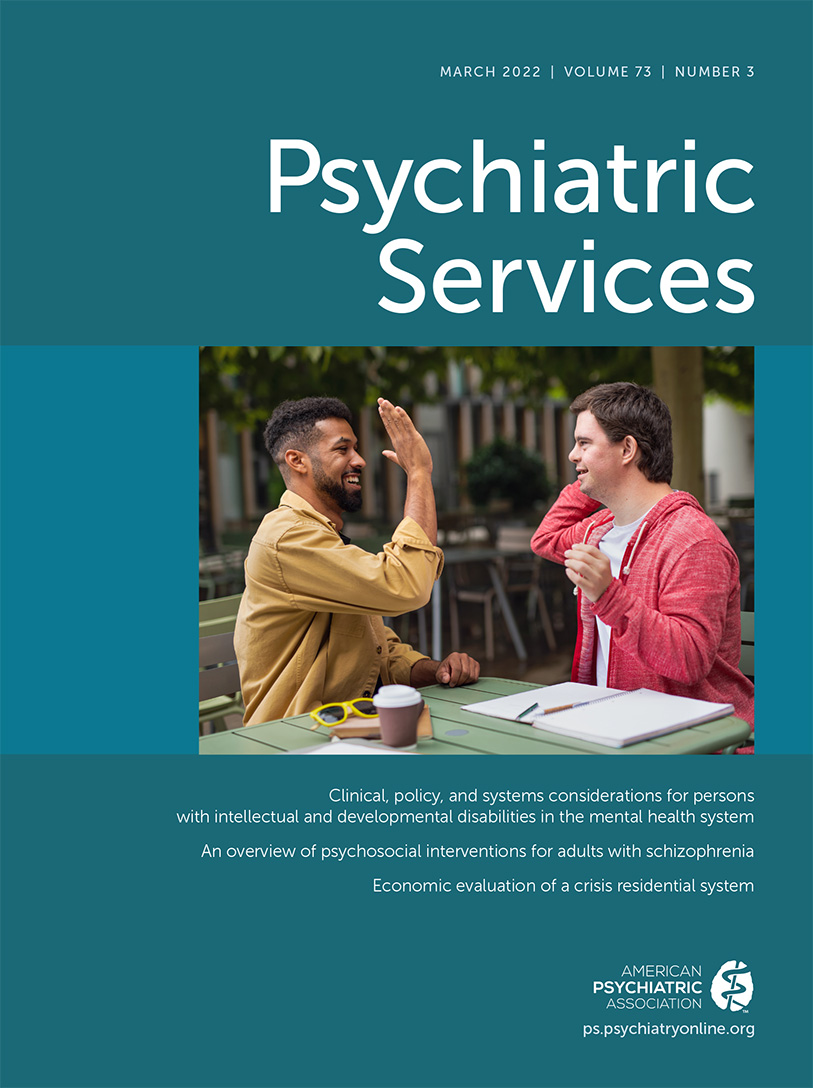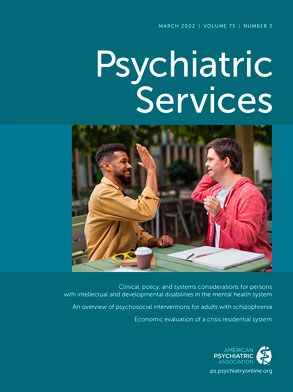Obsessive-compulsive disorder (OCD) is characterized by persistent, unwanted, distressing thoughts (obsessions) and attempts to control or dismiss these thoughts and reduce the distress they provoke (compulsions). Epidemiological studies have found that OCD has a lifetime prevalence of 2%, half of cases start by age 19, and the course is typically chronic, with waxing and waning symptoms (
1,
2). Frequently disabling, OCD is associated with significant functional impairments, poor quality of life, and decreased educational attainment and work productivity (
3–
5).
The two evidence-based first-line treatments for adults and children with OCD are cognitive-behavioral therapy (CBT) involving exposure and response prevention (EX/RP) and pharmacotherapy with serotonin reuptake inhibitors (SRIs) (
6). As monotherapy or in combination, these two treatments have been shown in multiple randomized controlled trials to reduce symptoms and improve functioning (
7). However, OCD is often not detected nor diagnosed (
8). Underdetection may be due to reduced help seeking as a result of individuals’ not recognizing or reluctance to disclose OCD symptoms; it may also be due to clinician misdiagnosis. Even when OCD is diagnosed, lack of access to care (e.g., CBT) and problems with quality (e.g., suboptimal prescribing of SRIs) also contribute to the quality gap in OCD care (
8).
Education and clinician training are important first steps in addressing this gap (
9). Thus, we developed a workforce development program called Improving Providers’ Assessment, Care Delivery, and Treatment of OCD (IMPACT-OCD); this program is supported by the New York State Office of Mental Health (NYS-OMH) and a partnership among NYS-OMH, the Center for Obsessive Compulsive and Related Disorders, the Center for Practice Innovations (CPI) at Columbia Psychiatry, and the New York State Psychiatric Institute. The goal of this program is to improve clinician knowledge and skills in OCD care and raise awareness of OCD among clinicians, individuals with OCD and their families, and the general public. This Open Forum will describe how implementation science methods were used to engage stakeholders, assess practice determinants, and develop a multifaceted training strategy for IMPACT-OCD.
Strategy Development
Stakeholder engagement.
Our first step was to engage an advisory board, including frontline clinicians, behavioral health agency leadership across New York State, NYS-OMH leadership, and individuals with lived experience of OCD. We also engaged the International OCD Foundation (IOCDF), a large international nonprofit organization whose primary mission is to raise awareness about OCD. The advisory board convened monthly meetings to engage local champions and discuss how and where individuals with OCD present in the NYS-OMH system, to assess determinants of practice and inform training strategy development, and to provide feedback on the content, format, and dissemination of all training materials.
Assessment of practice determinants.
We used the implementation science framework, the Consolidated Framework for Implementation Research (CFIR) (
10), to learn about the facilitators and barriers that may influence implementation of evidence-based care for OCD. Specifically, the CFIR guided our qualitative inquiry (e.g., advisory board meetings and interviews) and quantitative methods (e.g., survey of learning needs), with the goal of identifying potential facilitators and barriers from the “inner” setting (i.e., access to knowledge and information, leadership engagement, available resources) and the “outer” setting (i.e., external policies or incentives, patient needs and resources).
Qualitative findings.
The IMPACT-OCD advisory board members identified the longstanding relationship between CPI and the NYS-OMH clinician community and its use of the statewide online training platform as facilitators. Inner-setting barriers included community clinicians’ lack of knowledge in the assessment and treatment of OCD and lack of administrative time to complete training, and outer-setting barriers included public misunderstanding about OCD and patient reluctance to disclose symptoms.
Quantitative findings.
To learn more about the inner-setting barriers, we conducted a survey of the learning needs of behavioral health clinicians (N=194) in NYS-OMH clinics (Patel S, Bernero L, Chiang I, et al., 2021, unpublished manuscript) as part of a series of educational webinars. These webinars provided basic information about OCD and included a prewebinar survey to assess clinician knowledge about OCD and confidence in diagnosing and treating it. Survey results showed low levels of clinician knowledge (only 5%, N=10 answered questions about OCD treatment correctly) and low confidence in diagnosing (54%, N=105) and treating OCD (73%, N=143), confirming inner-setting barriers raised by our advisory board and cited in prior literature (
11,
12). This survey also revealed clinicians’ perspectives (N=173) on the types of educational materials needed to help individuals with OCD (outer setting), such as educational pamphlets (65%, N=113), videos about OCD (46%, N=80), and community resources for treatment (68%, N=118). Advisory board members with lived experience underscored the need for public education about the different ways OCD can present clinically and about evidence-based treatments. They also emphasized the need for accessible tools that individuals with OCD might use when seeking therapists with expertise in EX/RP.
Strategy development.
Armed with information about practice determinants, we identified several strategies and vetted their acceptability and feasibility with our advisory board. After this process, we determined that our multifaceted training strategy will consist of a series of e-learning modules to improve clinician knowledge in OCD care, a support service for clinicians whereby they could discuss their patients with OCD with clinical experts from the Center for OCD and Related Disorders, and a web-based toolkit of educational materials and resources for clinicians and for individuals with OCD and their families. These are described below.
Multifaceted Training Strategy
E-learning modules.
To reach the geographically dispersed workforce and offer training accessible at the clinician’s convenience, we developed a series of e-learning modules focused on four topics: “How to Detect and Diagnose OCD: Tips and Tools,” “Exposure and Response Prevention: A Cognitive Behavioral Therapy for OCD,” “Pharmacological Treatment of Obsessive-Compulsive Disorder: Nuts and Bolts,” and “OCD and Schizophrenia-Spectrum Disorders: How to Differentiate and Treat.” These topics were chosen on the basis of the learning needs survey described above. Modules were disseminated via CPI’s online learning management system to clinicians in NYS-OMH clinics. Continuing education across a range of disciplines (psychiatry, psychology, social work, and mental health counseling) were offered as an incentive for participation. Evaluation (before, during, and 3 months after training) of these modules will include assessment of satisfaction, acquisition, and application of knowledge in practice as well as future implementation support needs to provide OCD care (e.g., clinical consultation, ongoing supervision, learning collaboratives).
Support service.
Because online training alone is not sufficient for practice change (
7), we also developed a NYS-OMH–funded support service for clinicians, whereby they could access clinical experts (a psychologist and psychiatrist with >10 years of experience treating OCD) from the Center for OCD and Related Disorders to discuss their patients with OCD. As part of this service, clinicians can request guidance on assessment, diagnosis, and evidence-based treatment of OCD through an online survey. Experts review survey responses and conduct a telephone consultation with the clinician within 7 business days. This service will be evaluated in terms of its feasibility and satisfaction and will identify future training and implementation support needs.
Toolkit.
We developed a web-based IMPACT-OCD toolkit with two components. One component hosts educational materials, treatment tools (e.g., what to ask your EX/RP therapist), and links to treatment directories for children and adults with OCD and their families, and the second component hosts resources for clinicians on the assessment, diagnosis, and evidence-based treatment of OCD (e.g., OCD treatment algorithm) (
https://practiceinnovations.org/Initiatives/IMPACT-OCD/Resources). Evaluation of the toolkit will include website analytics, including click-through rates and a brief feedback survey on toolkit material and resource helpfulness, and satisfaction, and will identify future informational needs.
Discussion
In several ways, IMPACT-OCD builds on the lessons learned from existing educational and training programs focused on OCD. For example, the IOCDF uses several direct-to-consumer marketing strategies to educate the public and clinicians about practice guidelines and to ensure that individuals and their families looking for treatment find the necessary resources (
13). We also used implementation science methods to design a multifaceted training strategy based on the needs of our stakeholders, and we continually evaluate the use of resources and stakeholders’ experiences. Studies examining the IOCDF’s Behavior Therapy Training Institute, which offers 3-day in-person training in EX/RP (
14), have demonstrated that training programs can increase clinician’s skills, positive beliefs, and comfort related to EX/RP. Yet clinicians report greater skill use when they received additional support after training (facilitator) and difficulty integrating exposures into practice due to time or location constraints (barriers). Learning from this research, IMPACT-OCD worked to address the inner- (i.e., clinician knowledge and confidence) and outer-setting barriers (i.e., practice workflow, time for training, public misunderstanding about OCD, reluctance to disclose symptoms) in the multifaceted training strategy described above. Given that ongoing consultation after training is a critical element in increasing the effectiveness of training (
15), IMPACT-OCD also offered a support service to provide clinicians a venue for clarification and skill practice.
To develop IMPACT-OCD, we engaged stakeholders and assessed practice determinants and used this information to identify strategies for our workforce development program. However, this was only a first step. Guided by summative evaluation, the IMPACT-OCD will continue to develop iteratively on the basis of clinician identification of additional training topics and intensive supports needed to promote practice change (e.g., practice facilitation, learning collaboratives) as well as toolkit improvements based on feedback from clinicians, individuals, and families. Future work will determine whether our methods may be adapted by mental health agencies or systems of care interested in exploring a workforce development program to improve the quality of care for often undetected and undertreated disorders such as OCD.

